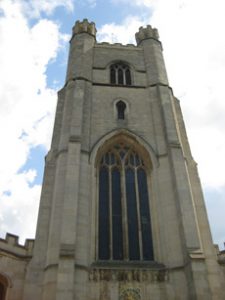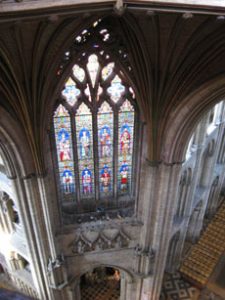Student Reports: Carrie Lloyd, England, 2010, Part Three
Cambridge
Monday, May 17

Today the group was taken on a tour of Cambridge University. Though it’s blasphemous to say, considering that the two are ancient rivals, I found it very similar to Oxford. The teaching methods, multiple colleges, and detailed architecture were similar to each other, if very different from a typical U.S. college. We spent time in King’s College Chapel where we’d gone for church the day before and got to take a closer look at the fan-vaulted ceiling which was decorated with the Tudor Rose, Portcullis, and Fleur de Lys, ornate organ and wooden screen gifted by Henry VIII to Anne Boleyn and has now had all of her initials removed save one, the beautiful stained glass windows, and Rubens’s Adoration of the Magi at the altar.
We also saw Trinity College, famous for being one of the wealthiest colleges and student Sir Isaac Newton. Trinity College Chapel was a little different from King’s College Chapel in that the walls were whitewash instead of bare stone and the ceiling was decorated with painted wood. It housed several statues of former students including Newton and Tennyson. The Wren Library was also part of Trinity, but we plan to visit it separately.
Tuesday, May 18

We visited Ely Cathedral today which is located in Cambridgeshire. The surrounding land was part of an East Anglican princess’s dowry, Etheldreda. After her second marriage, she requested to be freed to become a nun and returned to Ely to found a monastery around 673. When Etheldreda died, she was buried in the church and her tomb became a point of pilgrimage. Around the turn of the first century, the nave was built and still remains as it did, providing a beautiful example of Norman work. About 200-300 years later, the Galilee porch and central octagon were added; two examples of gothic architecture. In fact, the octagon is the only gothic dome left in the world. Overall, Ely Cathedral is valued for its span of architectural styles and age. My favorite part of the visit was when we climbed up into the octagon dome and out onto the roof. We not only got to see the wooden framework supporting the dome, but also got to open panels of the tower and see across to the other side. Climbing to the top was also worth note since it felt like a trek out of Alice in Wonderland. The staircases were narrow and spiraled tightly and the doors were tiny enough to make even the shortest of us duck our heads. The view was incredible from the top and our guide pointed out several places that were visible from the roof which were miles away.
Our second stop of the day was at Bury St. Edmunds which is the ruin of an abbey founded in 633 and turned into a Benedictine monastery in 1020 by Edward the Confessor. It is remembered for its association with the Magna Carta since in that in 1214, Cardinal Langton and the barons swore at St. Edmund’s altar that they would force King John to accept the ratification of the Magna Carta. Unfortunately, it is now ruins because the limestone bricks were stolen, allowing the exposed rock to wear away, leaving flinty remains. The gardens were beautifully maintained and we were able to explore them and the rest of the town at leisure.